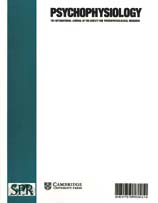Crossref Citations
This article has been cited by the following publications. This list is generated based on data provided by
Crossref.
Öhman, Arne
1999.
Contributing to Confusion Rather than to Knowledge: A Commentary on Mayer et al..
Journal of Psychophysiology,
Vol. 13,
Issue. 3,
p.
160.
Chen, Denise
and
Haviland-Jones, Jeannette
2000.
Human Olfactory Communication of Emotion.
Perceptual and Motor Skills,
Vol. 91,
Issue. 3,
p.
771.
Chen, Denise
and
Haviland-Jones, Jeannette
2000.
Human Olfactory Communication of Emotion.
Perceptual and Motor Skills,
Vol. 91,
Issue. 3,
p.
771.
Miller, Mark W.
and
Patrick, Christopher J.
2000.
Trait differences in affective and attentional responding to threat revealed by emotional stroop interference and startle reflex modulation.
Behavior Therapy,
Vol. 31,
Issue. 4,
p.
757.
Davidson, Richard J.
Putnam, Katherine M.
and
Larson, Christine L.
2000.
Dysfunction in the Neural Circuitry of Emotion Regulation--A Possible Prelude to Violence.
Science,
Vol. 289,
Issue. 5479,
p.
591.
Lang, Peter J
Davis, Michael
and
Öhman, Arne
2000.
Fear and anxiety: animal models and human cognitive psychophysiology.
Journal of Affective Disorders,
Vol. 61,
Issue. 3,
p.
137.
Vuilleumier, Patrik
Armony, Jorge L.
Driver, Jon
and
Dolan, Raymond J.
2001.
Effects of Attention and Emotion on Face Processing in the Human Brain.
Neuron,
Vol. 30,
Issue. 3,
p.
829.
Spangler, Gottfried
Emlinger, Susanne
Meinhardt, Joerg
and
Hamm, Alfons
2001.
The specificity of infant emotional expression for emotion perception.
International Journal of Psychophysiology,
Vol. 41,
Issue. 2,
p.
155.
Öhman, Arne
and
Mineka, Susan
2001.
Fears, phobias, and preparedness: Toward an evolved module of fear and fear learning..
Psychological Review,
Vol. 108,
Issue. 3,
p.
483.
Vuilleumier, Patrik
and
Schwartz, Sophie
2001.
Beware and be aware: Capture of spatial attention by fear-related stimuli in neglect.
Neuroreport,
Vol. 12,
Issue. 6,
p.
1119.
Pessoa, Luiz
Kastner, Sabine
and
Ungerleider, Leslie G
2002.
Attentional control of the processing of neutral and emotional stimuli.
Cognitive Brain Research,
Vol. 15,
Issue. 1,
p.
31.
Ladwig, Karl-Heinz
Marten-Mittag, Birgitt
Deisenhofer, Isabel
Hofmann, Birgit
Schapperer, Johannes
Weyerbrock, Sonja
Erazo, Natalia
and
Schmitt, Claus
2002.
Psychophysiological Correlates of Peritraumatic Dissociative Responses in Survivors of Life-Threatening Cardiac Events.
Psychopathology,
Vol. 35,
Issue. 4,
p.
241.
Finn, Peter R.
2002.
Motivation, Working Memory, and Decision Making: A Cognitive-Motivational Theory of Personality Vulnerability to Alcoholism.
Behavioral and Cognitive Neuroscience Reviews,
Vol. 1,
Issue. 3,
p.
183.
Volz, Martin
Rey, Eibe-Rudolf
Bailer, Josef
Kirsch, Peter
and
Hamm, Alfons O.
2002.
Emotionale Reaktionen schizophrener Patienten mit Anhedonie:.
Zeitschrift für Klinische Psychologie und Psychotherapie,
Vol. 31,
Issue. 2,
p.
77.
Tipples, Jason
Young, Andrew W.
Quinlan, Philip
Broks, Paul
and
Ellis, Andrew W.
2002.
Searching for threat.
The Quarterly Journal of Experimental Psychology Section A,
Vol. 55,
Issue. 3,
p.
1007.
Pessoa, L.
McKenna, M.
Gutierrez, E.
and
Ungerleider, L. G.
2002.
Neural processing of emotional faces requires attention.
Proceedings of the National Academy of Sciences,
Vol. 99,
Issue. 17,
p.
11458.
Pessoa, Luiz
Kastner, Sabine
and
Ungerleider, Leslie G.
2003.
Neuroimaging Studies of Attention: From Modulation of Sensory Processing to Top-Down Control.
The Journal of Neuroscience,
Vol. 23,
Issue. 10,
p.
3990.
Levenson, Robert W.
2003.
For distinguished contributions to psychophysiology: Arne Öhman.
Psychophysiology,
Vol. 40,
Issue. 3,
p.
317.
Grillon, Christian
and
Baas, Johanna
2003.
A review of the modulation of the startle reflex by affective states and its application in psychiatry.
Clinical Neurophysiology,
Vol. 114,
Issue. 9,
p.
1557.
Amodio, David M.
Harmon-Jones, Eddie
and
Devine, Patricia G.
2003.
Individual differences in the activation and control of affective race bias as assessed by startle eyeblink response and self-report..
Journal of Personality and Social Psychology,
Vol. 84,
Issue. 4,
p.
738.


